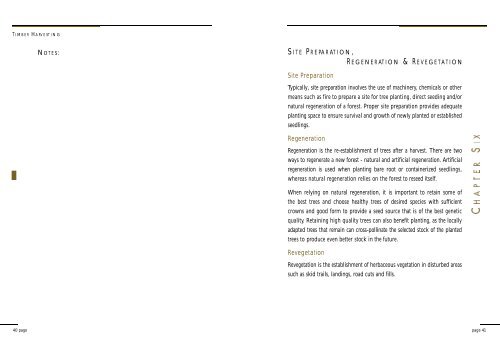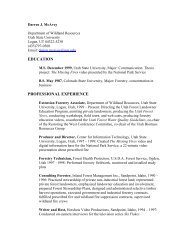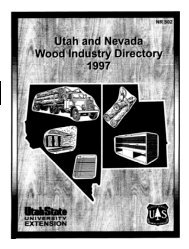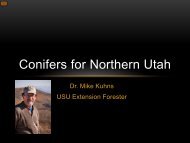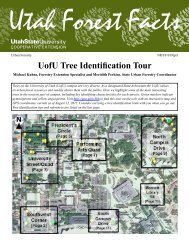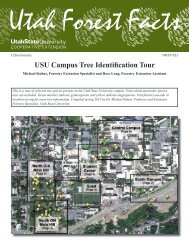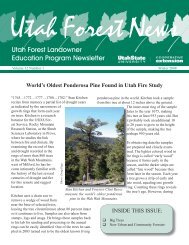A Technical Manual for Landowners, Loggers, and ... - Forestry
A Technical Manual for Landowners, Loggers, and ... - Forestry
A Technical Manual for Landowners, Loggers, and ... - Forestry
You also want an ePaper? Increase the reach of your titles
YUMPU automatically turns print PDFs into web optimized ePapers that Google loves.
R O A D S, S K I D T R A I L S , L A N D I NG S & S T R E A M C R O S S I NG S<br />
R O A D S, S K I D T R A I LS , L A N D I NG S<br />
& S T R E A M C R O S S I NG S<br />
D i ve rsion Ditch<br />
A diversion ditch or spreader ditch is designed to remove water from the road<br />
surface to the downhill side of outsloped roads. Diversion ditches should be<br />
graded on a 2 to 3 percent slope to allow constant drainage <strong>and</strong> dispersion<br />
into nearby <strong>for</strong>est vegetation. Diverting water off the road <strong>and</strong> into vegetation<br />
allows sediment to settle out <strong>and</strong> the water to be absorbed into the ground.<br />
These are the least costly of the water diversion devices.<br />
Figure 4.6 Diversion Ditch<br />
Figure 4.7 Ditch Relief<br />
Dirt Ditch<br />
Road Surface<br />
3'<br />
Cut Slope<br />
1'<br />
C ross Culve rt s<br />
Cross culverts should be installed to drain water from either the inside ditch<br />
or from natural water sources such as seeps or small springs. The size the<br />
cross culvert should be designed to adequately h<strong>and</strong>le peak runoff <strong>and</strong> flood<br />
waters. Generally, size culverts to h<strong>and</strong>le a 25 year–24 hour storm event <strong>for</strong><br />
temporary road crossings <strong>and</strong> a 50 year–24 hour storm event <strong>for</strong> permanent<br />
road crossings. Cross culverts should be skewed 15 to 30 degrees toward<br />
inflow ditch to reduce maintenance requirements.<br />
Figure 4.8 Cross Culvert<br />
Dirt Ditch<br />
Road Surface<br />
Culvert<br />
C ross Dra i n a ge<br />
In-sloped roads require cross-drain culverts or ditch-relief culverts to allow<br />
water to cross to the downhill side of the road. In-sloped roads rely on<br />
drainage ditches on the inside of the road to carry the water away from the<br />
cut bank <strong>and</strong> roadside. Ditch gradients of 2 to 6 percent are best.<br />
Compacted Under<br />
Catch Basin<br />
Rock / Energy Dissipator<br />
Wa ter Bars<br />
Water bars are best suited <strong>for</strong> use on roads that receive little or no use <strong>for</strong> an<br />
extended period of time. To construct a water bar, excavate a trough one to<br />
two feet deep by three to four feet wide at an angle of 30 to 45 degrees across<br />
the road. The uphill end of the water bar should be connected to the upper<br />
bank of the road. A properly constructed water bar also has an outlet on its<br />
20 page<br />
page 21


